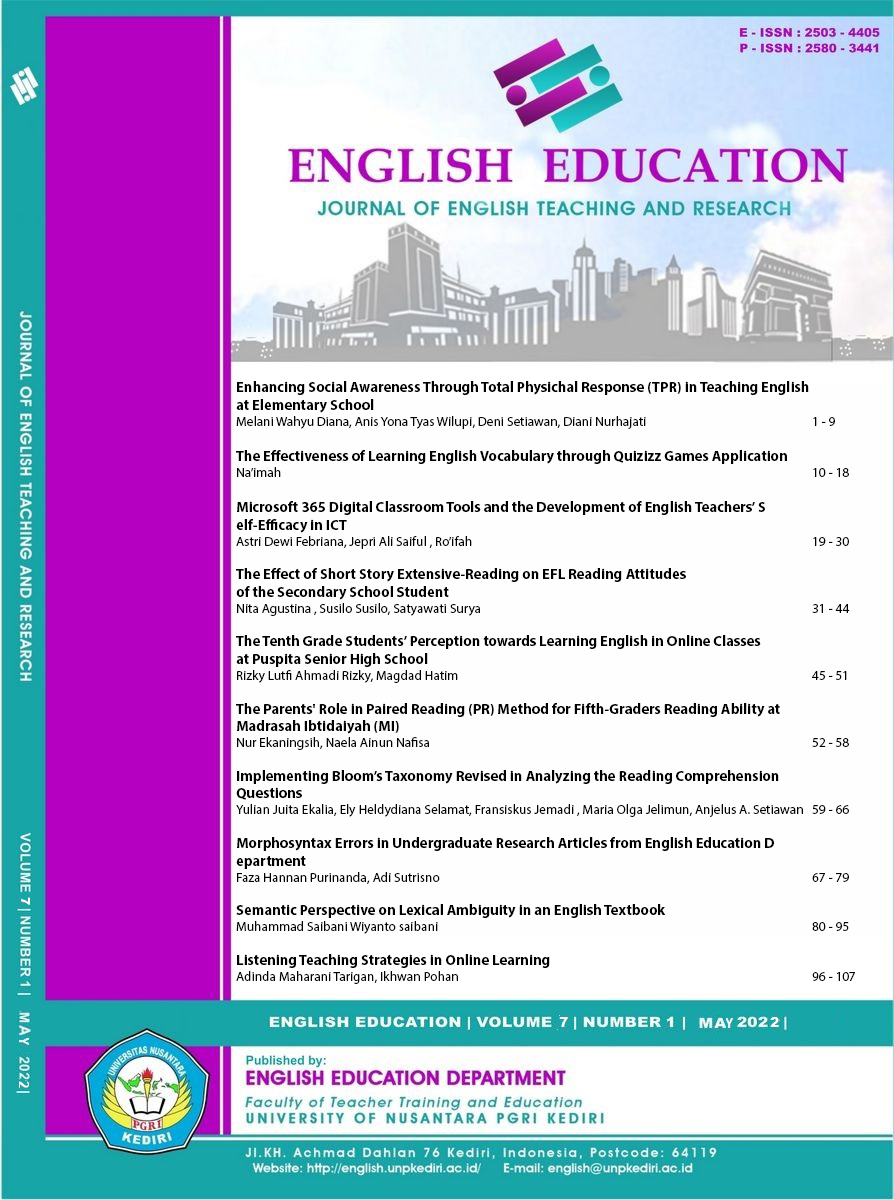Morphosyntax Errors in Undergraduate Research Articles from English Education Department
DOI:
https://doi.org/10.29407/jetar.v7i1.17862Keywords:
morpheme, syntax, research article, undergraduateAbstract
Since the graduates of English education department are expected to be educators, errors that are still prevalent in their research articles need to be acknowledgedas teaching what is essentially flawed language use may lead to damaging results.Therefore, the aim of this research is to inspectprevalent morphological and syntactical errors in undergraduate research articles from English education department and determine the factors causing the errors. The results of the study show that errors are found at both morphological and syntactical levels. The morphological level includes inflection, derivation, preposition, article, possessive determiner, quantifier determiner, copula be, and pronoun. Meanwhile, the syntactical level includes passive voice, tense, infinitive, noun phrase, adverbial clause, adjectival clause, auxiliary, and subject-verb agreement. As for the source of errors, both interlingual and intralingual factors are attributed to causing such errors.This study highlights the process of error classification andthe trend of frequently-made errors, including their commonality within the EFL context. Several suggestions are also offered in order that English learners can be more attentive to their writings.
Keywords:error analysis, morpheme, syntax, research article, undergraduate
Downloads
References
Abbasi, M., & Karimnia, A. (2011). An Analysis of Grammatical Errors among Iranian Translation Students: Insights from Interlanguage Theory. European Journal of Social Sciences, 25.
Abushihab, I. (2014). An Analysis of Grammatical Errors in Writing Made by Turkish Learners of English as a Foreign Language. International Journal of Linguistics, 6(4), 213. https://doi.org/10.5296/ijl.v6i4.6190
Anantri, T. A. (2017). An Error Analysis of Subject Verb Agreement in Narrative Writing of The Tenth Grade Students of Madrasah Aliyah Negeri 2 Palembang. UIN Raden Fatah Palembang.
Anggraeni, L., & Irwan, R. (2019). An Error Analysis of The Mechanics in Students’ Paragraph Writing of Recount Text (A Case Study at The Eighth Grade of MTs N 2 Surakarta in Academic Year 2018/2019). IAIN Surakarta.
Anwar. (2010). Analysing Morphological Errors on Students’ Composition at Centre of Learning Lingua (COLL) in Mamuju. Universitas Islam Negeri Alauddin Makassar.
Brown, H. D. (2006). Principles of Language Learning and Teaching (5th ed.). Pearson Education ESL. https://books.google.co.id/books?id=jUF0QgAACAAJ
Dulay, H. C., Burt, M. K., Krashen, S. D., & Krashen, S. (1982). Language Two. Oxford University Press. https://books.google.co.id/books?id=oBBZAAAAMAAJ
Ellis, R. (2015). Understanding Second Language Acquisition 2nd Edition - Oxford Applied Linguistics. Oxford University Press. https://books.google.co.id/books?id=dZrICgAAQBAJ
Gayo, H., & Widodo, P. (2018). An Analysis of Morphological and Syntactical Errors on the English Writing of Junior High School Indonesian Students. International Journal of Learning, Teaching and Educational Research, 17, 58–70. https://doi.org/10.26803/ijlter.17.4.4
Greenbaum, S. (1990). A Student’s Grammar of the English Language. Pearson Education. https://books.google.co.id/books?id=9BtyyIQT3_AC
Hamdi, D. S. (2011). An Analysis of Written Grammatical Errors of Tunisian Learners of English in EFL Context.
Hussain, R. (2019). An Analysis of Undergraduate Saudi EFL Female Students’ Errors in Written English Essays. Arab World English Journal, 241–258. https://doi.org/10.24093/awej/efl1.17
James, C. (1998). Errors in Language Learning and Use: Exploring Error Analysis. Longman. https://books.google.co.id/books?id=DLBoAAAAIAAJ
Keshavarz, M. H. (2012). Contrastive Analysis and Error Analysis: New Edition Updated and Enlarged (3rd ed.). Rahnama Press. https://books.google.co.id/books?id=0XMunwEACAAJ
Köroğlu, Z. Ç. (2014). An Analysis on Grammatical Errors of Turkish EFL Students’ Written Texts. International Periodical For The Languages, Literature and History of Turkish or Turkic, 9(12), 101.
Krashen, S. D. (1981). Second Language Acquisition and Second Language Learning. Prentice Hall. https://books.google.co.id/books?id=GXczlAEACAAJ
Mutmainah, E. (2019). Morphological Error Analysis in Writing Skill of Recount Text at The Eighth Grade Students’ of MTs N 2 Surakarta in Academic Year 2018/2019. IAIN Surakarta.
Nuryanto, E. (1990). Essentials of English Sentence Structure. Yayasan IKK.
Richards, J. C., & Schmidt, R. W. (2013). Longman Dictionary of Language Teaching and Applied Linguistics. Taylor & Francis. https://books.google.co.id/books?id=ziSsAgAAQBAJ
Rohmana, W., & Jianggimahastu, P. (2019). Error Analysis of Students’ Recount Text Writing – Junior High School Student. JETLe (Journal of English Language Teaching and Learning), 1, 10. https://doi.org/10.18860/jetle.v1i1.7757
Saputri, N. (2018). Morphological and Syntactical Error Analysis on The Students’ Descriptive Composition of Private Vocational High School. Scope : Journal of English Language Teaching, 1, 174. https://doi.org/10.30998/scope.v1i02.1353
Sari, Z. P., Sukirlan, M., & Sudirman. (2014). An Analysis of Students’ Errors in Writing of Recount. U-JET, 3(7).
Savitri, W. E., & Akhiriyah, S. (2016). Errors Analysis of The Sentences Made by Freshmen of English Department. IJET (Indonesian Journal of English Teaching), 5(2), 282–293. https://doi.org/10.15642/ijet2.2016.5.2.282-293
Taşçı, S., & Aksu Atac, B. (2018). Written Grammatical Errors of Turkish Adult Learners of English: An Analysis. 4, 1–13.
Wahyuningsih, S. K. (2016). Grammatical Errors Analysis in the Descriptive Writing of the Semester 3 Students of English Education Department of STAIN Gajah Putih. Journal of Education, 1(1), 60–65.
Downloads
Published
Issue
Section
License
Authors who publish with this journal agree to the following terms:
- Copyright on any article is retained by the author(s).
- The author grants the journal, the right of first publication with the work simultaneously licensed under a Creative Commons Attribution License that allows others to share the work with an acknowledgment of the work’s authorship and initial publication in this journal.
- Authors are able to enter into separate, additional contractual arrangements for the non-exclusive distribution of the journal’s published version of the work (e.g., post it to an institutional repository or publish it in a book), with an acknowledgment of its initial publication in this journal.
- Authors are permitted and encouraged to post their work online (e.g., in institutional repositories or on their website) prior to and during the submission process, as it can lead to productive exchanges, as well as earlier and greater citation of published work.
- The article and any associated published material is distributed under the Creative Commons Attribution-ShareAlike 4.0 International License








 Article template
Article template



